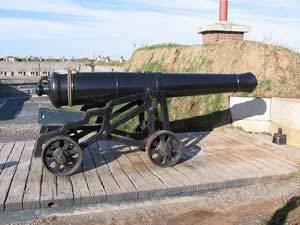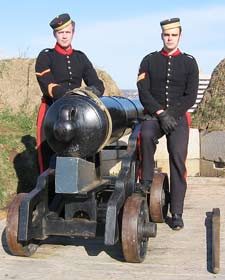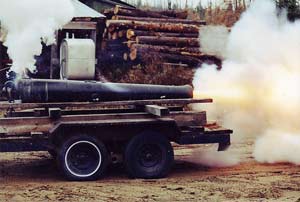
 |
|
Navigation links at
the bottom of the page
|
|
Sleeving the Halifax noon day gun
by John C. Moss |
||||||
|
(Editorial note: This site welcomes well-researched articles on
the theme of underage soldiers and army apprentices in all
armies. The following article is courtesy of John Moss of Nova Scotia,
Canada.) How d'you weigh a whale, asks the deep sea fisherman. Take it to a
whaleway station. How d'you fix a cannon? Put a sock in it might be
the smart answer, but it's not the correct one. Better to bore it out
with modern machine tools and sleeve it with a steel liner.
|
||||||
|
When muzzle-loading guns of old were loaded and fired, the repeated
explosion of gun powder in the barrel could build up a residue of hard
carbon. As the battle went on, the residue got hot and became a danger
to the loader whose job it was to use a wooden rod to push the charge
to the back of the barrel. A hot barrel of clinker could ignite the
charge, but it was not so much the carbon residue that posed the danger
because, between firings, every muzzle-loading gun was swabbed with
a damp sponge. This was because smouldering debris was often left over
from the cartridge itself or from the wadding used to prevent gas leakage
around the shot (guns were loaded with cartridge, wad, and shot). After
a gun was fired, debris was first removed with a wad hook or worm,
then the gun was sponged and loaded again.
|
 |
|||||
|
Photo: John C. Moss
The Halifax noon day gun of Parks Canada |
||||||
|
In times of peace, a variety of bugles, trumpets, drums, guns and,
in the case of highland regiments, bagpipes marked important intervals
in the daily routine of garrisons. In the British Army, bugle and drum
calls had been practice since the mid-17th Century with the creation
of Cromwell's New Model Army.
In port garrisons such as Halifax, Nova Scotia, a gun marked the daily routine. The soldier's day was strictly ordered from reveille to the sounding of the 'last post' at night. Some garrisons fired signal guns three times a day: morning, noon and evening. In others - Vancouver, British Columbia, for example, the signal was, and still is, given twice a day. The noon day gun in Halifax has been a feature of city life since it was first garrisoned by the British Army in 1749. The gun in use today is a replica of an 19th Century 12-pounder muzzle-loading gun of the Blomefield design, which has been in use since it replaced an earlier muzzle-loader in the 1870s. The replica is reputed to have been cast in Collingwood, Ontario, but there is no certainty about this. The Blomefield pattern was a system of scales and proportions developed by Colonel Thomas Blomefield in the late 1700s (c 1790). His system, based on the calibre of the weapon, specified the length, wall thickness and other dimensions of the muzzle-loader gun. These specifications replaced the Armstrong gun in use up to the 1780s and 90s, which was nevertheless used throughout the French Wars (1793-1815). As a weapon of war, a muzzle-loader was capable of firing ball, shell, grape, and chain shot. Throughout the Victorian era, twice daily gun signals were sounded in Halifax, one at noon, one in the evening. The firing of the noon day gun was timed for vessels in the harbour to set their chronometers by sight of the puff of smoke rather than the noise of the report, which took time to carry. The evening signal was fired at eight o'clock during the winter season and nine o'clock in the summer and told off-duty soldiers they had half an hour to return to barracks. Although the Halifax gun is now fired only once daily, the tradition
of noon-day signal has become a regular feature of city life. In the
past, ships checked their global positions at noon by observing the solar
transit, which is the passage of the sun across the meridian. The Citadel
gun gave ships an accurate time reference. At one period, the 'noon gun'
was fired at one o'clock, which seems contradictory. Some experts in
naval history believe this was to allow ships time to concentrate on
the noon solar observation and to set their chronometers an hour later.
A tradition of observing a silence on Christmas day continues to this
day.
|
||||||
|
The practice of firing a gun at noon was widespread in European garrisons,
but particularly port garrisons. At one time, the signal was made from
a man o'war and only later taken over by the military garrison. According
to written records, the Halifax gun was fired from the ramparts of
the third citadel. The present citadel was declared complete in 1856
and it was from this year that tradition holds the signal came from
the Garrison artillery.
From the founding of Halifax in 1749, th Royal Regiment of Artillery was responsible for the garrison ordnance, one that remained until the departure of Imperial troops in 1906. Today, members of the Military Interpretation program portray the 3rd Brigage, RA. The year chosen for the style of uniform and equipment of the 3rd Brigade was 1860 when the unit was known to have been stationed in Halifax. The Royal Corps of Commissionaires, responsible for site security,
assumed the duties of firing the citadel gun once the British Army
took its departure. Later, the Halifax Citadel National Historic Site
of Canada organisation took over the duties previously discharged by
the Corps of Commissionaires. Parks Canada introduced its 'interpretation
program'.
|
 |
|||||
|
Photo: John C. Moss
Bombadier and Lance-Bombadier in attendance at the noon day gun |
||||||
|
The area outside the Citadel's main gate was known as the 'saluting
battery'. For a while, on ceremonial occasions, the saluting battery
was the position from which the gun was fired to mark the arrival and
departure of naval vessels. Today, the gun is positioned on the ramparts
above the main gate.
Halifax is not the only city to maintain the tradition of firing daily signals. The same traditions continue at Edinburgh Castle, Fort Henry in Kingston, Ontario, Signal Hill in South Africa and Vancouver, British Columbia. Vancouver has its gun firing at nine o'clock in the evening, but uses a steam whistle to announce the noon-day hour. The jet of steam serves the same purposes as smoke from a gun: it can be seen instantly in all parts of the extensive harbour by ships wanting to set their chronometers. The tradition of gunnery, so large a part of Halifax history, means that the replica gun is an important feature of city life, but not even replicas last forever. Loading and firing the gun daily might not seem to cause heavy wear, but time takes its toll on the metal, no matter how well the residue is removed. Hairline cracks and fissures on the inside surface of the barrel weakened the gun. The 12-pounder replica had been cast using much the same method of manufacture as that used for the gun it replaced. At the time a decision was made to fit a steel liner, the gun was actually fairly clean. What debris that could not be removed with a bucket and bore brush was blasted out with pressurized water. The main problem was that the interior metal surface of the bore showed evidence of those small cracks and fissures. A steel liner was therefore required to strengthen the barrel, maintain its integrity and not crack after repeated firing. This work required the services of a gun fitter. The question was where to find the skill and knowledge needed to restore the replica gun to good working order with a sleeve insert. Enter Tony Walsh, Ex-Royal Canadian Electrical and Mechanical Enginers, who runs a business in Watson's Corners, Ontario, specializing in the manufacture of replica weapons for military re-enactment groups in the United States and Canada. His helper in this work, Derek Holbeche, an armourer, served his apprenticeship in the British Army. The Canadian Army had a similar apprentice training program from 1942 until 1965, the year Minister of Defence Hellyer of the federal government brought in the Canadian Forces Unification Bill and ended the apprentice program. Although thousands of first-rate artisans, fitters, electricians and radar specialists came out of the Canadian program, gun fitter and armourer were not among the trades taught. An armourer is skilled in small arms, a gun fitter in large guns. With some training and experience, the skills of the two trades are virtually interchangeable. Apprentice training in the British Army all but ceased in 2002. Junior soldiers for infantry, trades and logistical support now attend a common military training college. Those considered suitable to follow technical trades take the same basic course of studies as their non-trades oriented fellow soldiers: 42 weeks of basic training, educational studies and fitness training. In the Canadian Army, between 1942 and 1945, an estimated 5,000 tradesmen went through the apprentice training program of the Canadian Technical Training Corps. It is a sad reflection the program in which young soldiers were taught a trade that would serve them well in civilian life ended in the Canadian Army and now, largely, the British Army has ceased apprentice training. That Derek Holbeche, a fomrer apprentice in the British Army, was able to use his armourer's skills on the Halifax gun was as fortuitous as an unexpected bonus to the work done. The gun barrel, seven feet long and weighing two tons, was loaded on to a transport truck in Halifax, Nova Scotia, and delivered to a lumber yard in Lanark, Ontario, about 1500 miles distant. At Lanark, it was transferred on to a lumber truck equipped with a hydraulic lifting arm and taken to the contractor's machine shop at Watson Corners. Sleeving the gun as a safety precaution was no small feat. This meant
re-boring the barrel to fit a steel liner that would to add mechanical
strength. During machining, the bore was found to have 'hard' spots
that made machining difficult and time consuming. Iron or steel supports
used in the sand mould for the original casting were probably the cause
of the hard spots. Molten metal poured into the casting cooled faster
than material farther from the supports. This fact made the cast harder
in the vicinity of the casting props. All this Derek Holbeche had learned
during his time as an apprentice armourer. To do the job properly,
tool bits used in the boring operation were reshaped, resharpened and
frequently replaced from encountering the 'hard bits'.
|
||||||
|
Completion of the modification work took a full year. Once the work
was completed, the weapon had to be tested. This was done by securing
the barrel on a bed of timber on the lumber truck and lighting the
charge of black powder through the touch hole.
Needless to say, the test went off with a bang and the skilled ex-soldiers, Tony Walsh and Derek Holbeche considered themselves well satisfied with their work. The reworked gun was shipped back to Halifax, mounted on its carriage and tumbrels and returned to service. At the ceremony of its first firing since the renovation work, the gun fired without a hitch as was to be expected from the skilled hands of its gun fitters. © John Moss 3 December 2005 |
 |
|||||
|
Photo by Tom Shoebridge
Mounted on a lumber truck, the sleeved 12-pounder replica gun is test fired |
||||||
|
I wish to acknowledge the generous assistance of those who offered their skill and expertise in the preparation of this article: Miriam Walls, Information Management Specialist, Parks Canada, Nova Scotia; Hal Thompson of Parks Canada, an authority on muzzle-loading guns; Ex-apprentice soldier Derek Holbeche (Arborfield 1952B), and Tony Walsh, Ex-RCEME of Watson's Corners, Ontario. |
||||||
|
||||||